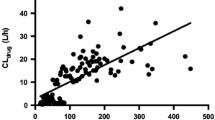Summary
Thermal trauma reportedly induces a spectrum of intricate physiological alterations that often involve cardiovascular, hepatic, renal, and dermatological functions. Individual responses to varying degrees of burn and secondary complications may produce unpredictable changes in the pharmacokinetics of drugs.
A number of reports describing the disposition of aminoglycoside antibiotics in burn patients have demonstrated clinically significant alterations in the pharmacokinetics of this class of drugs. Several authors have found significantly reduced serum half-lives in burn patients as compared with average values in non-burned subjects. Increased aminoglycoside clearances in some burn patients have been anributed to increased glomerular filtration secondary to elevated cardiac oulput, prostaglandin formation, and glucagon secretion: others anribute this to enhanced elimination of drug across damaged skin tissue. Monitoring of serum aminoglycoside concentrations is recommended because of the low therapeutic index of these agents and the variable course of renal function following burn injury.
Topical application of mafenide acetate. povidone iodine, and gentamicin to burn wounds has resulted in varying amounts of systemic absorption. Various systemic toxicities have been attributed to these topical therapies, especially in patients with compromised renal function. The extent and area of the burn, degree of hydration, and the amount of drug applied are factors influencing transcutaneous absorption. Sulphonamide derivatives are excreted in the urine subsequent to the application of silver sulphadiazine cream, but silver ions appear to be localised on surface tissue and are thus unavailable to the subeschar space.
Additional studies are needed to characterise the pharmacokinetics of medications commonly administered to burn patients. Unfortunately, the marked variability and fluctuations in pathophysiological status following burn trauma often confound the interpretation of such kinetic investigations.
Similar content being viewed by others
Author information
Authors and Affiliations
Rights and permissions
About this article
Cite this article
Sawchuk, R.J., Rector, T.S. Drug Kinetics in Burn Patients. Clin-Pharmacokinet 5, 548–556 (1980). https://doi.org/10.2165/00003088-198005060-00003
Published:
Issue Date:
DOI: https://doi.org/10.2165/00003088-198005060-00003




